Blueberries’ incredible anti-aging power comes from their high concentration of anthocyanins and polyphenols that literally repair your DNA damage within an hour of eating them. These compounds cross your blood-brain barrier to enhance memory and cognitive function while reducing harmful inflammation throughout your body. You’ll get cellular protection through enhanced antioxidant defenses that neutralize free radicals, plus cardiovascular benefits from improved blood vessel function and lower blood pressure. Discover how these tiny superfruits can extend your lifespan.
The Science Behind Blueberries’ Cellular Protection Mechanisms

When you consume blueberries, you’re activating powerful cellular defense mechanisms that work at the molecular level to combat aging. The high phenolic content in blueberries enhances your antioxidant defenses by downregulating reactive oxygen species (ROS) and reducing lipid peroxidation.
This protection extends to your skin, where polyphenol-enriched blueberry compounds offer photoprotective effects against UVB-induced inflammation and preserve skin thickness.
Your cells benefit from blueberry extracts through improved viability and proliferation, particularly in hippocampal cells. The compounds modulate critical pathways including NF-κB and mitogen-activated protein kinase (MAPK), which influence cell survival and inflammation. The protective effects occur through dose-dependent mechanisms, with higher concentrations of anthocyanins providing enhanced antioxidant enzyme activities.
Additionally, blueberries target inflammatory markers like iNOS and NOX-2, while reducing mast cell and neutrophil recruitment that contributes to cellular damage and accelerated aging.
Anthocyanins: The Powerhouse Compounds Fighting Free Radical Damage
Your body faces constant bombardment from free radicals that accelerate aging and cellular damage, but anthocyanins in blueberries act as powerful defenders against this oxidative assault.
These remarkable compounds work by neutralizing reactive oxygen species before they can wreak havoc on your cells, effectively reducing the oxidative stress that leads to premature aging.
When you consume blueberries regularly, you’re providing your DNA with essential protection against free radical damage that could otherwise compromise your cellular integrity and longevity. Research demonstrates that high-purity blueberry anthocyanins achieve impressive antioxidative potency, with EC values as low as 14.99 μg/mL for ABTS radicals and 26.48 μg/mL for DPPH radicals.
Neutralizing Cellular Oxidative Stress
As free radicals wreak havoc on your cells throughout the day, anthocyanins—the vibrant compounds that give blueberries their deep blue hue—act as your body’s molecular defense system.
These powerful antioxidants directly scavenge reactive oxygen species (ROS), preventing cellular damage before it occurs.
But anthocyanins don’t stop there. They stimulate your body’s production of critical antioxidant enzymes like catalase and superoxide dismutase, creating a sustained protective effect.
Additionally, they inhibit ROS-forming enzymes such as NADPH oxidase, cutting off oxidative stress at its source. Anthocyanins also react effectively with nitrogen species, providing comprehensive protection against diverse cellular threats.
The chemical structure of different anthocyanins determines their effectiveness. Delphinidin, with its three hydroxyl groups, demonstrates particularly potent radical-scavenging abilities, making blueberries an exceptional choice for neutralizing cellular oxidative stress and supporting healthy aging.
Protecting DNA From Damage
While oxidative stress threatens your cellular integrity, blueberry anthocyanins provide a sophisticated defense system that actively guards your DNA from damage.
These flavonoid pigments don’t just scavenge free radicals—they directly bind to your DNA and modulate essential repair genes like Gadd45, MDM2, p21, and p53.
When UV radiation or oxidative stress fragments your genetic material, anthocyanins trigger cell cycle arrest in G1 phase, giving your cells time to repair before replication. This prevents dangerous mutations from passing to new cells.
Research shows consuming 300 grams of blueberries reduces DNA damage by 18% within just one hour.
The protection works even after damage occurs, with anthocyanins restoring both fragmented and non-fragmented DNA while reducing stress protein expression that could lead to cancerous transformation. However, this protective effect is transient, with DNA vulnerability returning within two hours of consumption.
How Flavonoids Enhance Neural Communication and Brain Health
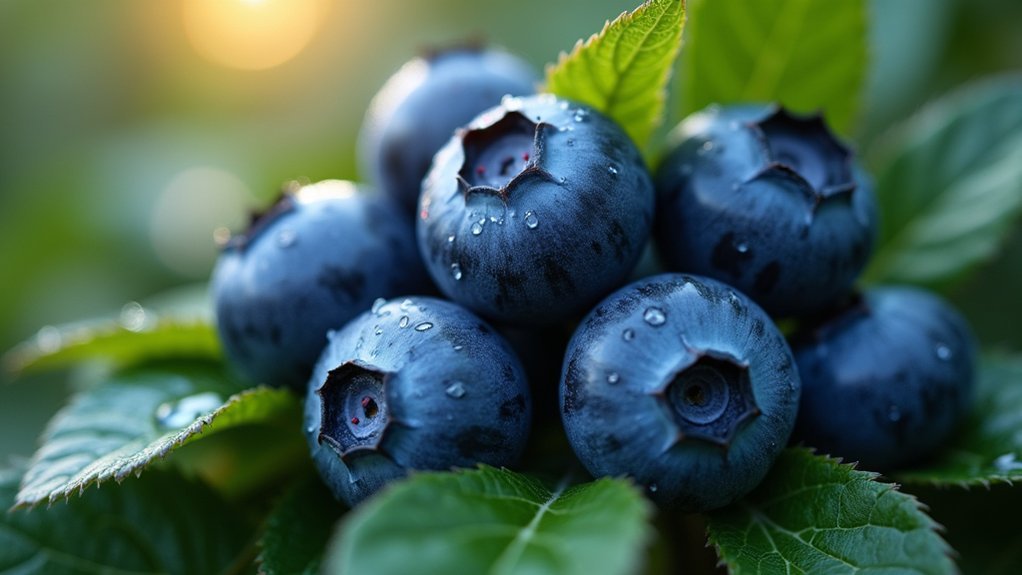
Your brain’s neural networks get a significant boost when flavonoids from blueberries cross the blood-brain barrier and interact with neurons directly.
These compounds strengthen the connections between brain cells by promoting synaptic plasticity, which enhances your ability to form new memories and maintain existing ones. The neuroprotective effects occur through ERK signaling pathways that help prevent neuronal damage and support cellular repair mechanisms.
You’ll experience better cognitive function because flavonoids protect your neurons from damage while simultaneously improving blood flow to critical brain regions.
Flavonoids Strengthen Neural Connections
When you consume blueberries, their flavonoids don’t just deliver antioxidants—they actively strengthen the communication highways in your brain.
These powerful compounds enhance neuroplasticity by modulating critical signaling pathways like MAPK and PI3K/Akt, which directly influence synaptic plasticity and memory formation. Your brain’s ability to adapt and reorganize itself improves as flavonoids stimulate synaptic protein synthesis, making neural connections more resilient and efficient.
The strengthening effect extends beyond individual neurons. Flavonoids enhance vascular blood flow, ensuring your brain receives ideal nutrient delivery and oxygenation. These compounds also suppress microglia activation, reducing neuroinflammation that can damage neural pathways and impair cognitive function.
This improved circulation supports neurogenesis, particularly in your hippocampus—the brain’s memory center. By protecting neurons from oxidative stress and neurotoxins while simultaneously boosting synaptic function, flavonoids create an environment where neural connections can thrive and strengthen over time.
Memory Protection Mechanisms
As flavonoids cross the blood-brain barrier, they trigger a cascade of memory-protecting mechanisms that fundamentally transform how your neurons communicate.
These compounds activate extracellular receptor kinase and protein kinase B/Akt pathways, directly enhancing your memory formation and recall abilities. You’ll experience improved spatial memory as flavonoids stimulate hippocampal BDNF production, supporting neural growth and protection.
Your brain benefits from flavonoids’ interaction with vital enzymes and proteins that regulate neurotransmitter function.
They’re activating neuroprotective pathways that shield your neurons from damage while promoting neuroplasticity throughout your life. This enhanced neural communication helps prevent age-related cognitive decline and reduces your risk of neurodegenerative diseases. Flavonoids also protect neurons from environmental toxins while simultaneously inhibiting harmful enzymes that could damage brain tissue.
Even a single dose provides protective effects, making blueberries powerful allies for long-term brain health.
Pterostilbene’s Role in Reducing Inflammation and Heart Disease Risk
While many compounds in blueberries contribute to their anti-aging benefits, pterostilbene stands out as a particularly powerful agent against inflammation and cardiovascular disease. This compound dramatically reduces inflammatory mediters in your body – studies show it drops COX-2 levels from 37.34 to 12.34 pg/mg and slashes PGE2 from 41.93 to 10.02 pg/mg.
You’ll also benefit from pterostilbene’s ability to suppress iNOS, which decreases damaging nitric oxide species that accelerate vascular aging.
Beyond inflammation control, pterostilbene protects your heart through enhanced antioxidant activity. It neutralizes free radicals that damage cardiovascular tissue, improves endothelial function, and prevents oxidative modification of LDL cholesterol – a key trigger for atherosclerotic plaque formation. Research demonstrates that pterostilbene also enhances your body’s natural defenses by boosting key antioxidant enzymes including SOD and GPx, which work together to combat cellular damage from reactive oxygen species.
Proanthocyanidins and Their Impact on Vascular Aging Prevention
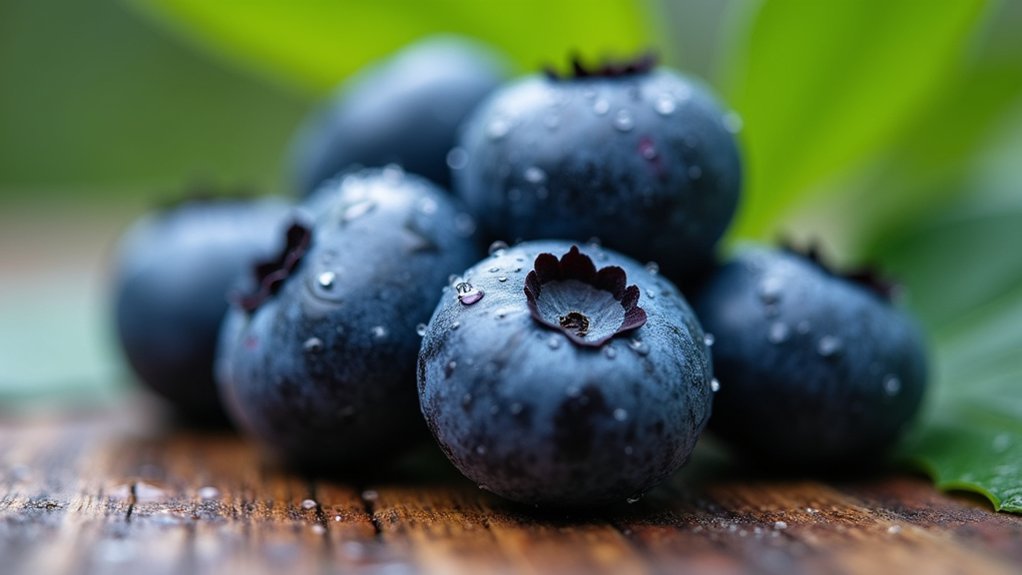
Beyond pterostilbene’s impressive anti-inflammatory effects, blueberries contain another powerful class of compounds called proanthocyanidins that specifically target the molecular processes driving vascular aging.
These compounds protect your cardiovascular system by suppressing inflammatory pathways, downregulating NF-kB and COX-2 in macrophages while reducing pro-inflammatory cytokines like TNF-α and IL-6.
You’ll benefit from their potent antioxidant properties that increase superoxide dismutase and glutathione peroxidase levels while reducing lipid peroxidation markers.
Proanthocyanidins also enhance your vascular function by improving endothelial health, increasing nitric oxide bioavailability for better blood flow, and preventing excessive smooth muscle cell proliferation. These compounds also demonstrate neuroprotective effects by preventing mitochondrial dysfunction and reducing oxidative damage in brain cells, which may help protect against age-related cognitive decline.
Regular consumption correlates with reduced cardiovascular disease mortality in middle-aged and elderly populations, making these compounds essential for maintaining youthful vascular health.
DNA Damage Reversal Through Blueberry Antioxidant Activity
Your DNA faces constant assault from free radicals that accelerate aging and cellular deterioration.
Blueberries’ powerful anthocyanins act as molecular shields, neutralizing these damaging compounds before they can wreak havoc on your genetic material.
These antioxidants don’t just prevent damage—they actually activate your body’s natural cellular protection mechanisms to repair existing DNA harm. Studies demonstrate that consuming 300 grams of blueberries can rapidly suppress DNA damage throughout your system.
Antioxidants Combat Free Radicals
As you age, your cells face constant assault from free radicals—unstable molecules that damage DNA and accelerate cellular deterioration.
Blueberries pack a powerful antioxidant arsenal that neutralizes these destructive molecules before they wreak havoc on your cellular structure.
The flavonoids in blueberries actively seek out and neutralize free radicals, creating a protective shield around your DNA. This mechanism reduces oxidative stress biomarkers throughout your body, effectively slowing cellular aging processes.
Studies demonstrate that consuming blueberries considerably decreases DNA damage markers compared to controls, with some research showing protection from just a single serving. Research shows that wild blueberry consumption can reduce oxidized DNA bases from 12.5% to 9.6% in participants.
Your cellular antioxidant defenses strengthen when you regularly consume blueberries, enhancing your body’s natural ability to combat oxidative damage and maintain healthier cells as you age.
Anthocyanins Neutralize DNA Damage
Within blueberries’ deep purple pigments lies a specialized class of antioxidants called anthocyanins that directly intercalate with your DNA strands to prevent and reverse cellular damage. These compounds work through multiple protective mechanisms to safeguard your genetic material from aging-related deterioration.
When you consume blueberries, anthocyanins immediately begin scavenging free radicals that would otherwise attack your DNA. They inhibit deoxyribose oxidation—a key marker of DNA damage—in a concentration-dependent manner.
Additionally, anthocyanins reduce DNA fragmentation by enhancing your cellular defense systems and modulating stress-related protein expression. These compounds also inhibit CYP2E1 enzymes, reducing harmful ROS production that leads to oxidative DNA damage. Research shows that anthocyanins activate Nrf2 pathways, which promotes your body’s natural antioxidant activity to further defend against cellular aging.
Cellular Protection Mechanisms
Beyond their direct DNA protection, blueberries activate extensive cellular defense networks that work systematically to reverse existing damage and fortify your cells against future threats. When you consume blueberries, their polyphenols trigger multiple protective pathways simultaneously.
| Mechanism | Action | Cellular Benefit |
|---|---|---|
| SOD/CAT Enhancement | Increases enzyme activity | Neutralizes free radicals |
| NF-κB Downregulation | Reduces inflammatory pathways | Controls cellular inflammation |
| ROS Reduction | Eliminates reactive oxygen species | Prevents oxidative damage |
| Nox4 Suppression | Decreases oxidative stress genes | Strengthens antioxidant defenses |
Your body converts blueberry compounds into powerful metabolites like ellagic acid and urolithins through gut bacteria. These molecules enhance your blood’s antioxidant activity while modulating VEGF levels for improved vascular health, creating thorough cellular protection. Fermented blueberry preparations show increased bioavailability compared to regular blueberry extracts, allowing for more potent therapeutic effects against cellular damage.
Cognitive Decline Prevention and Memory Enhancement Benefits
When you’re concerned about maintaining sharp mental faculties as you age, blueberries offer remarkable protection against cognitive decline through their powerful concentration of brain-boosting compounds.
Daily consumption equivalent to half a cup improves your executive functions, including memory updating and inhibitory control. You’ll experience enhanced word retrieval and reduced memory interference during learning tasks. These benefits translate to less everyday forgetfulness and faster information processing speeds.
Blueberries’ anthocyanins cross your blood-brain barrier, directly protecting neural tissue from oxidative stress and inflammation. Regular intake lowers your dementia risk while correcting harmful insulin resistance linked to neurodegeneration.
If you’re already experiencing mild cognitive impairment, blueberry supplementation shows even greater therapeutic potential, improving brain activity measurable through MRI imaging within sixteen weeks. Adults aged 75-80 demonstrate the most pronounced cognitive improvements from wild blueberry interventions.
Laboratory Evidence of Life Span Extension in Animal Studies
While cognitive benefits demonstrate blueberries’ remarkable brain-protective properties, laboratory studies reveal even more compelling evidence that these berries can actually extend your lifespan at the cellular level.
Scientists have tested blueberry polyphenols across multiple animal models with remarkable consistency.
The lifespan extension data includes:
- C. elegans roundworms – 28% mean lifespan increase (equivalent to 22+ additional years for a 79-year-old human)
- Drosophila fruit flies – 10% longer average lifespan with blueberry extract feeding
- Laboratory mice – calorie restriction plus blueberry extracts produced longer lifespans than either intervention alone
These aren’t just antioxidant effects.
The treated animals showed increased survival during acute heat stress, improved thermotolerance, and enhanced resistance to aging stresses, suggesting blueberries activate specific longevity pathways. Research indicates that blueberry compounds facilitate DNA repair and modulate aging-related genes at the cellular level.
Blood Pressure Regulation and Cardiovascular Protection
As researchers have documented remarkable lifespan extension in laboratory studies, they’ve simultaneously uncovered blueberries’ profound impact on cardiovascular health through multiple blood pressure regulation mechanisms. You’ll benefit from anthocyanins that inhibit ACE enzyme activity, reducing angiotensin II production and promoting vasodilation. Daily consumption of 200g blueberries measurably improves your blood vessel function and lowers systolic blood pressure.
| Mechanism | Cardiovascular Benefit |
|---|---|
| ACE Inhibition | Reduces blood pressure through vasodilation |
| Enhanced NO Production | Improves arterial flexibility and blood flow |
| Reduced Endothelin-1 | Decreases vasoconstriction and arterial stiffness |
| Antioxidant Activity | Protects vascular tissues from oxidative damage |
| eNOS Activation | Optimizes endothelial function and vascular tone |
Your endothelial function considerably improves within six weeks, supporting long-term cardiovascular protection. Regular blueberry consumption may also improve arterial stiffness, which is particularly beneficial since increased stiffness can strain the heart and contribute to heart failure.
Essential Vitamins and Minerals Supporting Multi-System Healing
Beyond cardiovascular protection, blueberries deliver a thorough array of vitamins and minerals that orchestrate healing across multiple body systems.
You’ll benefit from vitamin C’s collagen-boosting properties while vitamin K maintains your bone density. Folate supports vital cell division and repair processes, keeping your tissues healthy and resilient.
The mineral profile works synergistically to combat aging:
- Potassium and magnesium regulate blood pressure while supporting bone health and energy production
- Manganese and copper act as antioxidants, protecting connective tissues from age-related deterioration
- Iron guarantees ideal red blood cell function, maintaining proper oxygenation throughout your body
Vitamin E and B6 round out this nutritional powerhouse, protecting your cells from oxidative damage while preserving cognitive function as you age. With their composition of approximately 85% water, blueberries provide these essential nutrients in a highly bioavailable form that your body can readily absorb and utilize.
Metabolic Syndrome Prevention and Disease Risk Reduction
When metabolic syndrome threatens your long-term health with its cluster of dangerous risk factors, blueberries emerge as a powerful therapeutic food that can help reverse this condition’s progression.
You’ll experience improved lipid profiles as blueberries increase your HDL cholesterol levels while reducing total cholesterol and triglycerides.
These berries actively combat systemic inflammation by lowering IL-6 and TNF-α markers that drive cardiovascular disease risk.
Your vascular function improves greatly through enhanced endothelial health, reduced arterial stiffness, and increased nitric oxide activity.
Blueberries’ antioxidant compounds scavenge harmful free radicals, reducing oxidative stress markers like malondialdehyde and oxidized LDL.
This thorough approach helps you manage obesity-related cardiovascular risks, improve glucose metabolism, and prevent the dangerous complications associated with metabolic syndrome. Research shows that consuming one cup of blueberries daily for six months provides clinically significant improvements in heart health measures for adults with metabolic syndrome.
Optimal Consumption Strategies for Maximum Anti-Aging Benefits
To maximize blueberries’ anti-aging potential, you’ll need to consume one cup of fresh berries daily, though even modest intake of about one-third cup per day still reduces age-related disease risk considerably.
Just one-third cup of blueberries daily can significantly reduce your risk of age-related diseases and support healthy aging.
For ideal absorption, pair your berries with healthy fats like yogurt or nuts, which increase polyphenol uptake greatly.
Here are three key timing strategies:
- Morning consumption – Combat oxidative stress from overnight fasting when antioxidant activity peaks
- Regular snacking – Maintain sustained antioxidant levels throughout the day
- Three-month commitment – Cognitive benefits become noticeable after consistent daily intake
Choose fresh or frozen varieties over processed options with added sugars.
Avoid excessive heating to preserve delicate polyphenols. Blueberries specifically aid in generating new brain nerve cells while enhancing cellular communication. Consistency matters more than sporadic large portions—regular long-term intake amplifies anti-aging effects most effectively.
Frequently Asked Questions
Are Frozen Blueberries as Nutritionally Beneficial as Fresh Ones for Anti-Aging?
You’ll get nearly identical anti-aging benefits from frozen blueberries compared to fresh ones. They retain their antioxidants, anthocyanins, and vitamins when properly frozen, making them equally effective for cellular protection.
Can Blueberry Supplements Provide the Same Benefits as Eating Whole Berries?
You’ll get concentrated antioxidants from blueberry supplements, but you’re missing fiber, vitamins, and other nutrients found in whole berries that support digestive health and overall anti-aging benefits.
Do Wild Blueberries Contain Higher Antioxidant Levels Than Cultivated Varieties?
Yes, you’ll get twice the antioxidants from wild blueberries compared to cultivated ones. Wild varieties have a higher skin-to-pulp ratio, concentrating more anthocyanins and flavonoids in each cup you consume.
What Potential Side Effects Exist From Consuming Large Quantities of Blueberries?
You’ll likely experience digestive issues like bloating, gas, and diarrhea from excessive blueberry consumption. You might also develop allergic reactions, medication interactions from vitamin K, and temporary teeth staining from anthocyanins.
How Do Blueberries Compare to Other Berries for Anti-Aging Properties?
You’ll find blueberries outperform other berries in anti-aging research due to their higher anthocyanin content and superior bioavailability. They’ve shown more extensive cognitive benefits and neuroprotective effects than strawberries or raspberries.
In Summary
You’ve discovered that blueberries aren’t just delicious—they’re cellular powerhouses packed with anthocyanins, flavonoids, and pterostilbene that fight aging at the molecular level. You’re getting protection against free radicals, inflammation, and cardiovascular disease while supporting your brain health and metabolism. To maximize these anti-aging benefits, you’ll want to consume fresh or frozen blueberries regularly as part of your daily routine for ideal cellular healing and longevity.

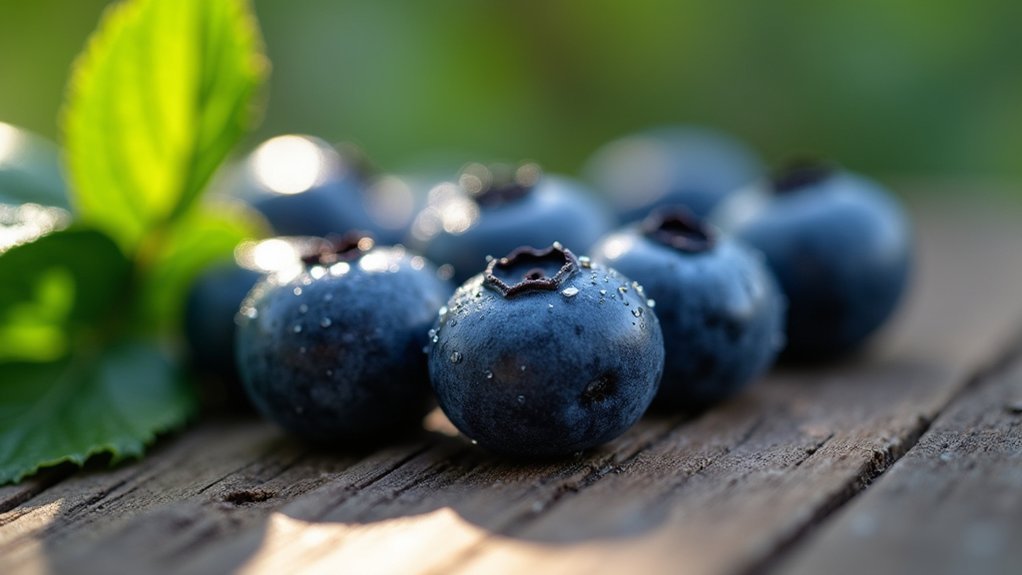
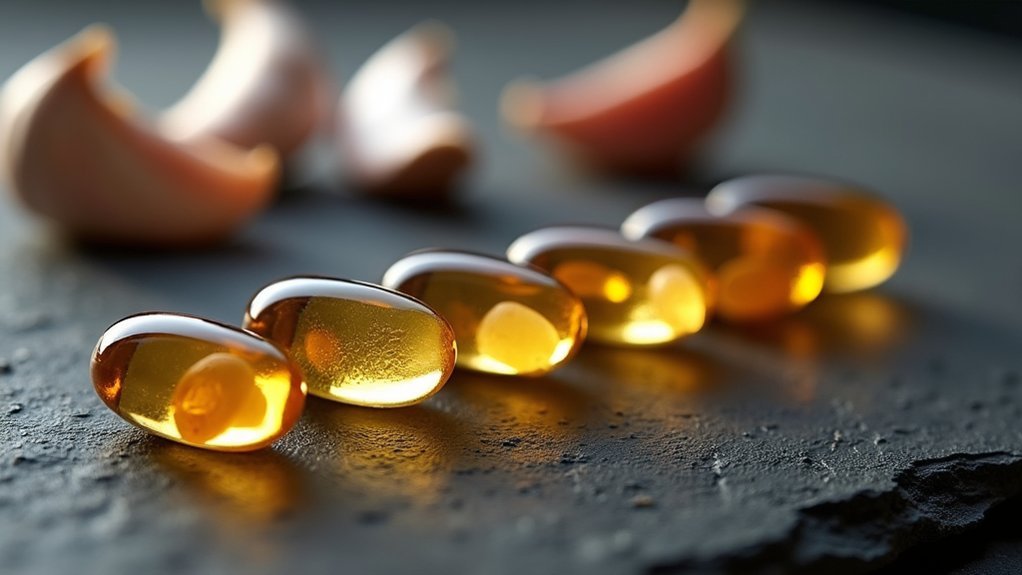
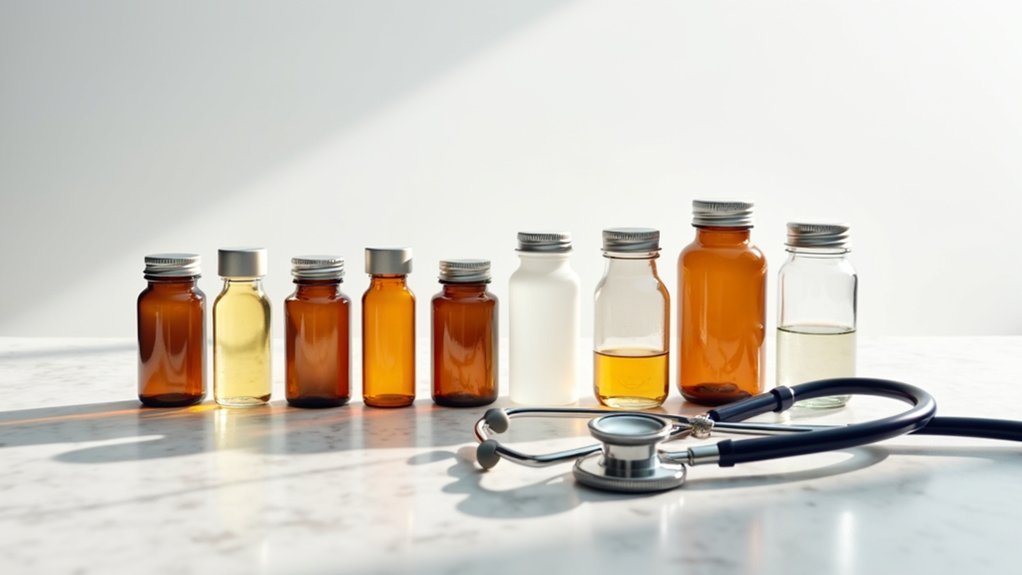
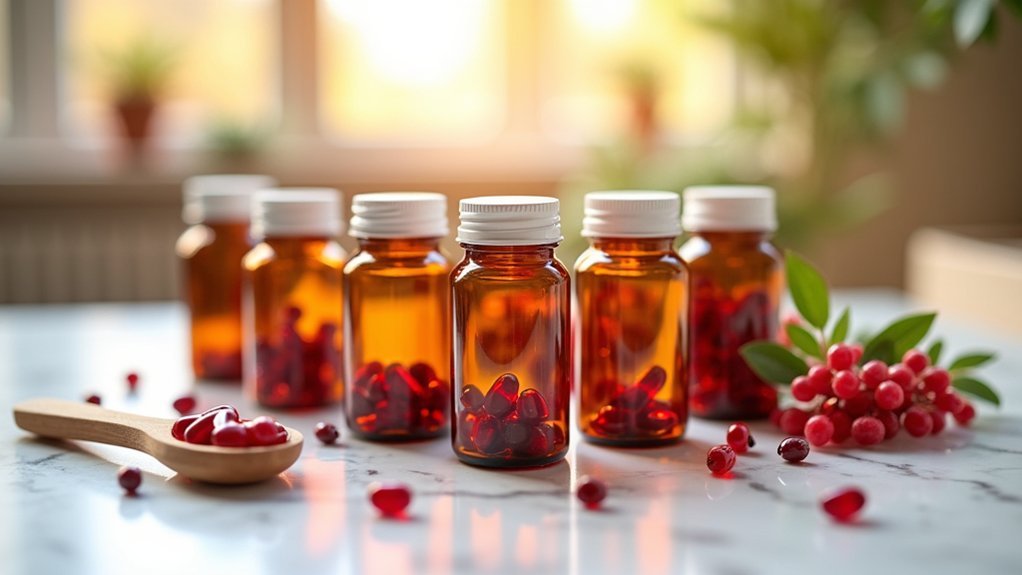
Leave a Reply